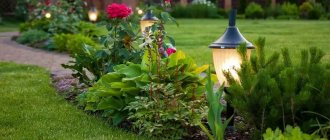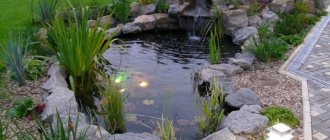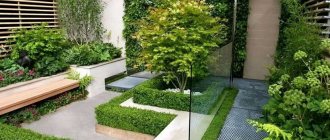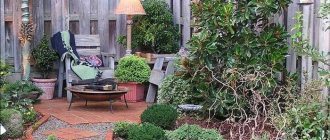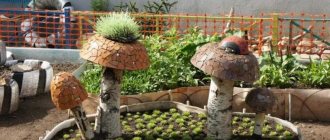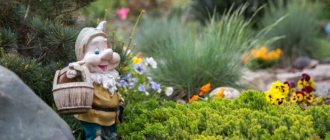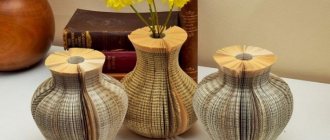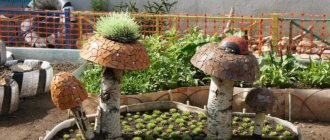Succulents are a real boon for compositions and creativity; they can be planted not only in shells, driftwood, coconut shells, cups, cracks on the walls, but also in anything your imagination suggests. Of course, we wouldn’t want to limit it, so here we will present only what will really be useful and will help you create your own unique composition with your own hands. The article is mostly a selection of photos, but there are also several universal master classes that will allow you to quickly master the main rules for designing compositions from succulents.
Let's start with the assortment
Let us describe groups of suitable plants and some specific “heroes”. Of course, the entire set of cultures cannot be covered in one article:
- Cacti. But not all of them are suitable for compositions.
- Aloe, various forms.
- Lithops (they are rarely used in compositions with other plants, because the agricultural technology of these plants is very peculiar). As a rule, different types of lithops are arranged in one pot, without other plants.
The most popular plants in compositions:
- Sedums.
- Rejuvenated.
- Aeoniums.
- Echeveria.
Sedums are a huge group of plants. In the photo below, on the left, there is a prominent sedum - plants 30-40 cm high, with bright decorative flowers, on the right - blue sedum - its height does not exceed 5-10 cm:
Young - well known under the name “stone rose” also includes a lot of hybrids:
Aeoniums are plants 25-30 cm high. There are many varieties and varieties:
Aeonium Arborium 'Schwarzkopf'
Aeonium Haworthii Variegta
Echeverias are very popular for creating continuous surfaces, especially flowing effects:
There are many varieties of echeveria. They are actively used for wall planters:
Miniature finestraria with cone-shaped leaves are good for tabletop compositions. Their agricultural technology is similar to that of Lithops: complete absence of watering in winter, careful and meager watering in summer, well-lit place.
Fenestraria Rhopalophylla
Finestraria with lithops.
Ampelous succulents
Rowley's ragwort - original ball leaves. Unpretentious.
Morgan's sedum is a fairly powerful plant with long stems densely covered with leaves. Hanging shoots resemble thick sausages.
Of course, the plant is highly decorative and solo, but it is also actively used in compositions. True, in the photo below there is a Burito sedum very similar to it:
Sedum Burrito:
Sedum Burrito
It is also worth looking at other representatives of the Crassulaceae family: cotyledons, pachyphytums, Kalanchoe, sedums, crassulas, graptopetalums . From other families, the following are suitable: euphorbia, peperomia, senecio, some species of agaves, haworthia, gasteria , representatives of the families Mesembryanthemum and Lastovnevye . Euphorbiaceae family may be suitable .
It makes sense to try your hand at arranging individually planted plants first:
Succulents in a bowl
Old dishes can serve as a good basis for creating a miniature garden. Just fill the containers with suitable soil, plant plants in them and place them anywhere in the apartment as you like.
Sequence of composition creation
Regardless of the size and shape of the composition, there are general rules for their creation:
- The base container is manufactured. It could be anything. If the composition is flat, a wooden box will do. Soil is laid in layers (universal soil half diluted with perlite is suitable), then a layer of moss.
- A metal mesh will be needed on top; it will allow you to hold the soil if the composition is not a floor one, but, for example, a wall one. Volumetric figures are also created from metal mesh. The mesh can be purchased at construction stores. You can secure it using a construction stapler.
- Seedlings are planted in the holes. You should wait several weeks (at least two) until the seedlings are well established and grow into the ground.
- The composition can be placed in the desired position.
- Watering is not necessary because succulents do not like dampness, but periodic spraying or spot watering will be required.
Now you know how to make almost any composition from succulents. Of course, this is a very simplified scheme, because such important things as the thickness of the soil layer, the mixing of the earth mixture, the selection of moss and decor, that is, in fact, everything that creates conditions for plant roots, are selected individually for each composition - one might say , "approximately". However, the aim is formed quite accurately with experience in growing succulents. If you have been seriously studying them for at least a year, feel their needs, know how to grow a healthy plant, where to put it, what to plant it in, how to water it, then there will be no problems with creating your own masterpiece mix.
A little theory: conditions for keeping succulents
In the article “Succulents: Tips for Beginning Flower Gardeners,” we have already mentioned how extensive the list of home succulents is – it is huge! It includes inhabitants of the desert, representatives of the tropics, and inhabitants of the continental steppes. It is clear that it is simply impossible to provide accurate content data suitable for all species. But there are general principles of care for the group of succulent plants.
- Lighting. The more light the better! But remember: not all varieties like direct sunlight.
- Watering. Twice a month - in summer, once - in winter.
- Priming. The mixture for compositions must contain peat, coarse sand, porous minerals (for example, zeolite) and vermiculite - they will increase breathability and make the soil quite light.
- Drainage. The quantity and quality of drainage is of great importance. The speed of plant growth depends on the thickness of the drainage layer. That is, the more drainage, the slower the succulent grows. This remark especially applies to rosette species.
Container selection
We decided not to waste printed signs, but simply show you as many different containers as possible. It is noteworthy that succulents can get by with a small amount of soil, so even the smallest objects can act as a container.
You can implement any image using:
Shells
Or their imitation from gypsum or cement:
The photo shows a cement sink made specifically for the composition.
Treated wood
It is better, of course, to use wooden containers as flowerpots, and plant the plants in a container that is less exposed to moisture.
Stumps and snags
A charming and very skillfully executed composition with shells.
Toys
Old pots and vases
And the more holey, the better:
Everything you can find in the kitchen
Cups, spoons, scoops for bulk products, baking dishes, beautifully decorated old tin cans, cups, out of order teapots, sardine cans, picnic baskets, candy dishes and dessert dishes:
Vintage of old cans, watering cans, plastic bottles, as in some of the photos above, is a separate process, no less interesting than creating compositions from succulents. It is noteworthy that none of the domestic craftswomen has yet mastered such processing of junk. Many of the arrangements pictured above in recycled vintage containers are commercial arrangements intended for sale. However, they are not much different from amateur ones made by hand, except that on the fly you can hone and simplify the details.
Chairs
There is something nostalgic in such compositions, where succulents tightly cover the chair and it’s not even about the style of the piece of furniture itself. The very fact that the furniture is completely overgrown with plants evokes associations with an abandoned garden and the romance of antiquity.
And even wine corks or eggshells
And in general - any items
Phyto-paintings
Wall paintings made of succulents are an original and unusual decoration for a room. But it is recommended to create them if you are already familiar with these plants and know the growth characteristics of different species.
The main rule is that you should not choose succulents that will quickly grow up.
To create a phyto-picture you will need a deep frame with a bottom. Young plants are planted in it and covered with a lattice. The composition is set aside for a period of several months to a year, until the succulents intertwine with each other through the root system and grow through the twigs.
Succulents go well with almost any material: sand, gravel, shells, moss, wood and others. They thrive in limited conditions and tolerate drought well. Thanks to this, you can create a wide variety of compositions from them, which will become an excellent decoration for any corner of the apartment.
Images
This is also purely a matter of imagination, so below are some photos for inspiration.
Landscapes with mountains and rocks
Below we will talk more about landscapes, only more complex. Recreating mountains, cliffs, islands lost in the white foam of sea waves is relatively easy to achieve. Use decorative stone chips, marbles, stones, driftwood, cobblestones, and their plaster imitations.
Stream or waterfall
The technique is quite popular - plants or stones imitate spilling water. This technique is often used in open ground flower beds, using ground cover flowers (pansies, ageratum, soapwort, aubrieta, arabis). Succulents will successfully cope with the same task. Blue-gray echeverias are ideal.
However, nothing prevents the spilled “waves” from being of a different shade:
Succulents can be an excellent addition to a stone stream:
Animals
How to make a florarium with your own hands?
To make your own florarium you will need:
Transparent container, glass or plastic
You can buy a ready-made one or look for it at home and adapt what you have on hand - jars, glasses, bottles, teapots and vases. Ready-made florariums can be found in almost any shape - cube, sphere, hemisphere, cone, cylinder, dome, but geometric florariums are the most popular.
For tropical florariums and orchidariums, containers with a small hole that create high air humidity are more suitable.
For succulents, you need to use containers with a wider mouth as they prefer low humidity levels.
Drainage
Expanded clay (with a fraction of less than 5 mm), pebbles or sand. Its layer should be larger than in a regular pot, at least 4 cm. In ready-made closed florariums, a double bottom is often used to remove excess water.
Florariums are very beautiful, where differently colored colored sand is used as a drainage layer.
Unfortunately, sand tends to mix up when watering, so in this case, try to plant the plants in the center of the container and water very carefully. This allows you to extend the decorative effect of the “layer cake” longer.
Plant substrate
Succulents will need a light sand mixture, orchids will need a special soil based on tree bark, the rest will need regular ready-made soil with the addition of perlite and vermiculite (30% of the total amount of soil).
It is better not to overdo it with fertilizers, use half doses. Plants that quickly begin to grow will spoil the appearance of the florarium.
Plants for florarium
Even a beginner who has never kept indoor plants before can master a florarium made from succulents, but creating a tropical forest will require a more serious approach and some knowledge.
Decorative elements
Mosses. Most often they use sphagnum or mosses of various types, which can be found in a pet store or aquarium department. They can only be used in tropical florariums.
Colored glass.
Stones, shells.
Natural materials: twigs, driftwood, dried flowers. Their use gives the composition a feeling of naturalness.
Decorative figures. They allow you to create a special or some small plot.
Ball and other three-dimensional hanging figures
This is a more difficult task. Ready-made succulent balls cost about 50 Euros on Etsy.
A ball is made from wire with a diameter of..., wrapped with the same mesh, but not completely, a little space should be left so that you can work with the inner surface of the ball. to lay out the surface with a very thick layer of moss and coconut fiber, then fill it with soil suitable for succulents, perhaps looser; a small diameter foam ball can be inserted into the center to prevent dampness and not make the composition too heavy. Close the grid. You can start planting plants.
Trees are created using the same principle.
Compositions in pots
Different types of succulents are beautifully combined in one ceramic, metal or plastic pot. When composing a composition, you need to approach it not only with imagination, but also with knowledge of plant biology: plant in one container those species that grow at approximately the same speed and do not stretch in length.
Panels, paintings and other wall compositions
For Valentine's Day:
Inscriptions and signs
The price of such an original pointer is about $30.
Nothing prevents you from posting any inscription using the same principle.
Wreaths on the door
They are not very popular here, although I must admit that a wreath, including one made of succulents, on a door or on a fence, looks attractive.
Panel from Ikea table
A quite popular online master class on making a composition from a table purchased at Ikea. It is worth noting that the idea is indeed successful and looks stylish.
Photo ideas for creating succulent gardens
If you still have questions, you can ask them in the comments to the article! Thank you for reading us, good luck in your creative flower growing business!
Imitation of landscapes and landscapes
The use of houses, stones imitating rocks, and miniature bridges makes compositions with succulents charming, but you should not take on such a composition without experience - trial options can be so far from the desired image that disappointment cannot be avoided. In addition to a carefully thought-out composition, preferably in advance and on paper, you will need to spend money on high-quality decor, or find natural materials for it, in addition, you should be well acquainted with the selected succulents.
Simpler in terms of planting are houses with overgrown roofs:
Just below, in a picnic basket, is a village landscape made by a Japanese craftswoman for sale. You can see how finely the details are worked out:
Succulents as an original table decoration
If you want to surprise your guests using custom table settings and natural materials, decorate the table with succulents. You can lay out wooden cutting boards as a base and place compact potted succulents on top.
Thanks to their small size, the plants will not block people sitting opposite them and interfere with the meal, and at the same time will create a cozy and pleasant environment.
Aquariums and gardens in a bank
Succulents and cacti are great for glass arrangements, despite the criticism. Particular attention should be paid to good drainage, because a glass container for succulents will be too humid, and lighting - because even ordinary glass absorbs light.
Caring for a garden in a jar means periodic spraying, and, of course, it is worth making sure that the room where it is located has clean, fresh air without dust.
And one more important point - the vessel should not be closed.
Petr Lapshin, curator of the collection of succulents at the Institute of Fracture of the Russian Academy of Sciences, harshly criticizes florariums and notes that succulents are completely unsuitable for growing in glass vessels. Let us not allow ourselves to agree with him on everything. Closed glass containers are really not suitable for succulents. However, now there are many vessels that are no less spectacular than closed ones, allowing you to provide succulents with suitable conditions for them, namely:
- Mandatory periodic drying of the soil.
- Good lighting.
In addition, it is worth noting that such compositions are designed to provide pleasure, and it does not have to be long-lasting. This composition is a good way of self-expression, an excellent gift or temporary interior decor. In a few months, plants, even succulents and even in conditions suitable for them, grow and the composition loses its appearance - it has fulfilled its functions, the plants can be planted in other containers, and a new composition can be created in the vessel.
You can use decorative sand
This sand is sold, for example, in the Fix Price network, or in stores for florists.
Options with sand are simple, they do not require a complex arrangement of plants, but in general, compositions “behind glass” are quite complex from a compositional point of view.
How to arrange beautiful succulents, how to combine them? There is a class of people who are able to beautifully compose any form without special training; if you are not one of them, then it makes sense to turn to literature. It is impossible to outline the basics of composition within the framework of this article, so we will simply recommend what to read:
- David Hession: everything about flower arranging - inexpensive and accessible. The book is focused specifically on arranging cut flowers and dried flowers, but the general principles of arranging shapes and lines can be mastered.
- From foreign ones exactly on the topic are books by Deborah Lee Baldwin. All about compositions made from succulents. However, they have not been translated into Russian.
Florarium
Florarium is a container made of glass or plastic, which can have a wide variety of shapes (ball, trapezoid, polyhedron, etc.).
It is the optimal solution for small apartments, because in a small area you can simultaneously collect many plants. Being limited by space, succulents will not grow and will retain their original miniature size.
Examples of beautiful compositional solutions
Many of them can be created based on the principles of arranging dried flowers and cut flowers. Consider: shape, color, size . Start creating a composition by varying only one parameter (for example, plants of the same shape and color, but different sizes), and then move on to the rest (plants of different shapes, colors, sizes). The photo shows compositions from simple to complex:
Using marbles.
Succulents in a tree
There are two options here. The first is to find a suitable piece of wood oriented in a horizontal plane and fill the internal space with soil. The second is to make kind of stumps from thick tree branches and use a special drill attachment to make round holes in them.
Living colors
For those who have achieved mastery in both growing succulents and cacti and arranging them, enormous opportunities open up for using these plants as paints. The color and shape of the plant are like brush strokes. Also, some of these compositions resemble knitting using the freeform technique.
Compositions with clay or ceramic figurines
With the help of succulents and various figurines, you can create entire fairy-tale worlds. If you have time and desire, try making houses, flowers, mushrooms and other decor from self-hardening clay with your own hands. If not, all this can be bought in the appropriate stores.
What to make the base for the panel from?
Make a simple wooden box or take a ready-made one. We choose the size and depth at our discretion.
Photo: Prepare a wooden box
Insulate the bottom of the box from moisture. You can lay cellophane, but we use foamed waterproof material, which is usually used to pack parcels. Place the box on top of it and trim off the excess. At the corners of the workpiece, a centimeter from each edge, we make perpendicular cuts 1 cm deep. We lay it so as to isolate the bottom and seams from leaks.
Photo: Protecting the box from moisture and leaks
Materials for a succulent wall
- Succulents – choose your favorite options. We recommend choosing greens with flat leaves and stems so they don't protrude too far from the wall. The quantity will vary depending on the size chosen. But we will talk about dozens.
- Frame – A frame with a recess will give you enough space to lay down soil and plant succulents. To determine what frame size is appropriate, think about where you want to hang your garden.
- Landscape Film – Landscape film will be used to protect the frame from the soil and will also help prevent water overflow.
- Hot Glue Gun – Use a hot glue gun to secure the trim to the frame.
- Peat Moss – Peat moss is used to fill a frame, plant succulents, and keep them fresh.
- Chain-link mesh – Wire mesh is ideal for holding soil in place. You can find it in stores or order it online.
- Furniture Stapler – A furniture stapler will help you secure the mesh to the frame.
- Scissors – Scissors will be needed for cutting materials, so be sure to have them nearby.
Can't decide which succulents are right for your wall? Use the recommended list below to get inspired.
Instructions
Step 1: Cut a piece of landscape film to fit the inside of the frame.
Take a piece large enough to cover the outer edges as well. Place the film in the frame to ensure it is the correct size.
Tip: Make sure the piece of film you use is slightly larger than the base of the frame. You can always cut off the excess.
Step 2: Use hot glue to secure the film.
Apply hot glue to all four walls of the frame and apply the film. Be careful, the glue may be hot on bare fingers. Once the film is secured, remove the excess with scissors.
Step 3: Fill the inside of the frame with peat moss. Add enough to fill the space.
Fill the entire interior, shaking the moss sideways to ensure even distribution. Because of its ability to hold water, moss will give your succulents the ideal amount of moisture they need to survive.
Step 4: Place the chain-link mesh and measure its dimensions to fit the frame.
Place a chain-link mesh over the frame to remove excess. It is important that it reaches the edges. Secure the mesh around the edges using a furniture stapler.
Step 5: Trim the roots of each succulent for planting.
Now it's time to give your succulents a new home. When you repot plants, you need to trim the roots of each one to ensure the garden grows properly and thrives. Remove excess soil from the roots to make it easier to place the succulents in the netting.
Step 6: Now it's time to plant your succulents.
Before pushing the roots into the moss, make some space for the succulent. Place it and press firmly into the moss. Repeat this step until the entire frame is filled. Vary your succulents in color and size to create the most interesting design.
Tip: If you have finished your garden but there is moss showing through in some areas, simply cut small pieces from a few plants and use them to fill the holes.
Step 7: Hang the garden and enjoy!
These easy-to-maintain displays can thrive anywhere. Place a living succulent picture on a table, shelf, or hang it on the wall. However, in the latter case, you need to wait until the plants are established (four to 12 weeks) before hanging the garden on the wall. Choose a location with sufficient sunlight. Since succulents are desert plants, they enjoy a nice, warm environment. Whether you are hanging your garden indoors or outdoors, this piece of decor is sure to brighten up any space.
Now that you have created your own garden, it is important to continue to take care of it. Follow the care instructions below.
- Water your succulents once a month. Place the frame on a flat surface and thoroughly wet the soil. Leave the garden horizontally for an hour, then make sure the frame is dry before hanging it on the wall again. Also keep in mind that the box does not have drainage, so do not use a lot of water.
- Spray the garden once a week . This will make the moss in the soil slightly damp.
A living wall is a stunning way to display your succulents. This project would also make a great gift for someone who appreciates something out of the ordinary.
The article was prepared based on materials from www.myfrenchtwist.com.
Varieties of outdoor succulents
This group of plants unites different families. Their representatives can be ground cover succulents, herbs, trees and even shrubs. Such types of succulents as vines and epiphytes will look very original; they can become the center of the entire composition. Many of them are beautiful in bloom.
Succulents can be classified according to various characteristics. For gardeners, the conditions in which plants should be grown are of greater importance:
- By interaction with the sun. Partial shade is loved by guernias, ceropegias, stapelias, green Crassulas, haworthias, green-covered gasterias, aloe, and sansevieria. And in a sunny meadow you can plant euphorbia, frithia, lithops, faucaria, pachyphytum, cotyledon, echeveria, sedum, graptoveria.
- By tenacity and growth of the root system. Mixes using hatior are an acceptable option even in small areas. This plant does not interfere with the growth of others, without losing its own attractiveness. And pachyphytum is demanding of the neighborhood in terms of localization - it actively expands during the growth process, so the distance to other plants must be appropriate. The root system of Crassula arachnoid is also quite voluminous; it reacts poorly to closed containers - pots and boxes. In vertical gardening, it is advisable to use rhipsalis, epiphyllum, and sedum.
- Curly . If you plan to design an arch, then it would be ideal to use Tradescantia.
- Tall. A hedge or space zoning is made from hoya (wax ivy).
Succulents can be used to decorate not only the interior of the house, but also its exterior.
When making a choice in favor of one plant or another, you should first consider its location on the site and its care options.
